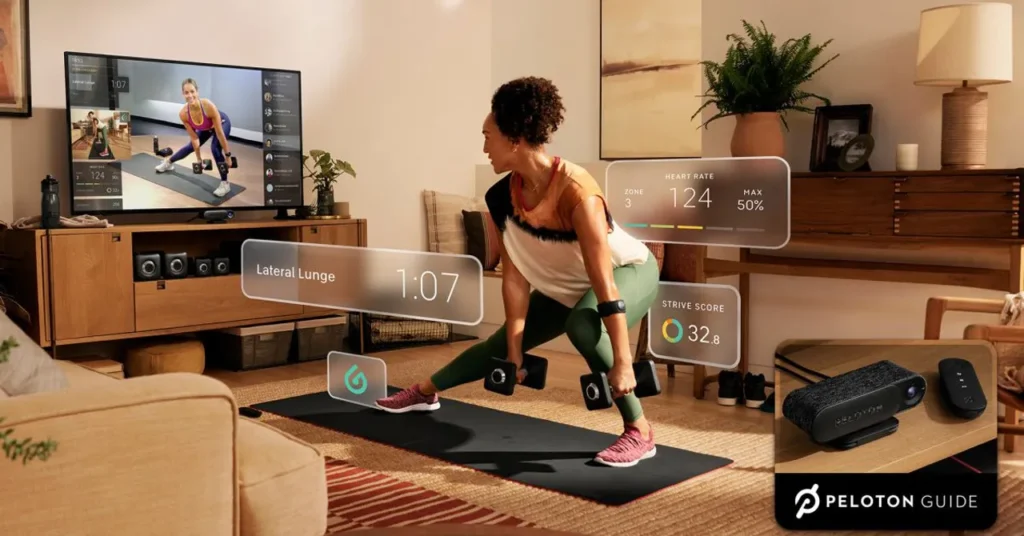The Rise of AI-Powered Home Gyms
Photo via Peloton
Just a few years ago, home workouts meant push-ups in the living room or a treadmill in the basement. Today, smart mirrors offer real-time feedback, AI coaches correct your form, and data-driven programs adjust your training automatically. Welcome to the new era of AI-powered home gyms—a revolution that’s transforming how we train without ever leaving the house.
This isn’t just a fitness trend. It’s a growing movement reshaping the intersection between technology, health, and convenience.
From Dumbbells to Data
At the core of this shift is artificial intelligence. More than just fancy algorithms, AI now enables machines to learn how we move, adapt to our goals, and even anticipate when we’re about to plateau. As a result, the modern home gym doesn’t just offer equipment—it acts like a personal trainer, always observing and adjusting.
This evolution is part of a larger shift in wellness. People want customized, accessible solutions that fit seamlessly into their daily routines. With AI, workouts are no longer static—they’re dynamic, reactive, and increasingly effective.
What Makes a Gym “AI-Powered”?
So what does an AI-powered gym include? In simple terms, it's a combination of smart hardware and intelligent software. Cameras, sensors, and motion-tracking tools collect data on how you move. Then, algorithms process that data to provide instant feedback or long-term adjustments.
For example, during a strength session, AI can tell if your squat depth is too shallow. It can suggest a slower tempo or remind you to engage your core. Over time, it notices patterns—like uneven strength between your arms—and modifies your plan accordingly.
These systems may live inside mirrors, screens, wearables, or compact strength machines. Yet regardless of their form, they all share one goal: to personalize fitness like never before.
The Key Benefits of AI Workouts
While traditional routines rely on repetition, AI workouts evolve based on your performance. Here’s how that benefits users:
1. Real-Time Feedback
No coach around? No problem. AI trainers correct posture, adjust pacing and offer cues as you move. This ensures better form and reduces injury risk—even in solo sessions.
2. Hyper-Personalization
Rather than following generic routines, users receive workouts tailored to their goals, body type, and progress rate. The more you train, the smarter your gym becomes.
3. Efficiency
By tracking recovery, fatigue, and performance, AI systems eliminate guesswork. You don’t waste time overtraining or repeating ineffective routines.
4. Motivation and Consistency
Many platforms include gamified features, leaderboards, or virtual communities to keep you engaged. Notifications and progress charts reinforce habits.
5. Privacy and Convenience
For those who prefer to sweat in private, AI gyms provide high-level coaching without the crowd, commute, or scheduling headaches.
Types of AI-Powered Equipment
Today’s smart gyms aren’t limited to one format. The range of AI-integrated products continues to grow.
Smart Mirrors
These full-length devices combine touch screens, motion tracking, and live coaching. While you move, they offer feedback and display metrics. Many simulate studio classes, complete with virtual trainers.
Connected Strength Machines
Some compact home systems now use digital weights and track resistance, range of motion, and rep speed. AI then adjusts future sets to maximize gains and prevent burnout.
AI-Driven Apps and Wearables
From wristbands to smart rings, many devices now gather biometric data—like heart rate variability or sleep patterns—and use AI to guide training intensity. The app becomes your coach, monitoring trends and recommending optimal recovery periods.
Virtual Reality Workouts
Though still developing, VR fitness uses motion sensors and headsets to create immersive training. Over time, these experiences may integrate full-body AI tracking for real-time correction in simulated environments.
Who Can Benefit Most?
Although AI-powered gyms sound high-tech, they’re surprisingly approachable. They’re particularly helpful for:
Beginners, who need form corrections and structure
Busy professionals, who want convenience and precision
Older adults, who appreciate joint-friendly coaching and balance tracking
Athletes, who use AI to fine-tune performance and recovery
Rehabilitation patients, whose progress can be monitored safely at home
Simply put, if you move your body, AI has something to offer.
Barriers and Considerations
Despite its potential, AI training isn’t perfect. Cost remains a barrier for some, with full systems ranging from several hundred to a few thousand dollars. Additionally, not all AI tools are created equal—some rely more on marketing than actual intelligent functions.
There’s also the question of data privacy. As these platforms collect personal health information, users must consider how that data is stored, used, and protected.
Still, many find the benefits far outweigh the trade-offs. And as technology improves, affordability and security are expected to follow.
The Future of Home Fitness
Looking ahead, the role of AI in fitness will only expand. Future iterations may offer:
Emotion-based coaching: Adapting workouts to your mood or motivation level
Full-body biometric scans: Offering in-depth assessments before and after workouts
AI-integrated nutrition: Suggesting meals based on activity, goals, and preferences
Voice-activated training plans: Conversational interfaces that coach in real-time
Eventually, your AI gym could become a holistic wellness assistant—tracking sleep, meals, stress, and movement in one seamless system.
Final Thoughts
AI-powered home gyms aren’t just about technology—they’re about transformation. By combining personalized coaching with convenience, they allow more people to train smarter, safer, and more consistently than ever before.
Whether you’re a fitness veteran or just starting, integrating AI into your home routine offers more than a high-tech upgrade—it provides a roadmap for long-term health and performance.
As the line between gym and gadget continues to blur, one thing is clear: the future of fitness has arrived—and it's learning more about you with every rep.
